The global hybrid rice seeds market is projected to grow from USD 5.9 billion in 2025 to USD 12.4 billion by 2035, registering a CAGR of 7.7%.
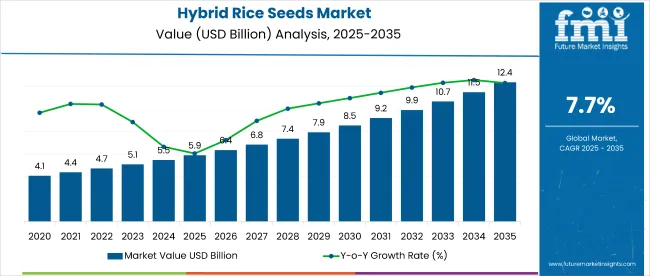
The market expansion is being driven by the increasing demand for higher yields, improved seed quality, and enhanced resistance to pests and diseases. Government initiatives, particularly in countries like India and China, are pushing the adoption of hybrid rice varieties to meet food security demands. Hybrid rice seeds are also gaining popularity due to their adaptability to various climatic conditions, including drought and salinity tolerance, which make them ideal for regions with challenging agricultural environments.
The market holds varying shares across its parent markets. It commands approximately 15% of the global agricultural seeds market, driven by the demand for high-yield and disease-resistant varieties. In the crop seeds market, it represents around 5%, reflecting its key role in rice cultivation. Although indirectly related, the hybrid rice seeds market contributes about 1% to the food and beverage market through increased rice production.
Within the agricultural equipment market, it holds a minimal share of less than 1%, as the equipment is generally designed for broader agricultural applications. Finally, in the seed treatment market, hybrid rice seeds account for roughly 3%, due to the necessity of specific treatments for enhanced germination and pest resistance.
Government regulations in major rice-producing countries such as India and China focus on ensuring food security, enhancing agricultural productivity, and promoting sustainable farming practices. Programs like India's National Food Security Mission (NFSM) and China's Super Rice Breeding Program are pushing the adoption of hybrid rice seeds to address the needs of growing populations.
These regulations, alongside initiatives in other Asian countries such as Vietnam and Indonesia, are accelerating the demand for high-yielding, disease-resistant hybrid rice seeds, ensuring that agriculture can keep up with the increasing food demand in the coming decades.
Japan is projected to be the fastest-growing market, with an expected CAGR of 8% from 2025 to 2035. Long grains will lead the grain size segment with a 50% share, while the 111 to 140 days will dominate the duration segment with a 40% share. The UK and Germany markets are also expected to grow steadily at CAGRs of 7.4% and 7.8%, respectively. The USA market is anticipated to grow at a CAGR of 7.2%, while France will witness moderate growth at a 7.7% CAGR.
The market is segmented by grain size, duration, and region. By grain size, the market is divided into long grains, medium-sized grains, and short grains. In terms of duration, the market is classified into up to 110 days, 111 to 140 days, and 140+ days. Regionally, the market is categorized into North America, Latin America, Europe, Asia Pacific, and the Middle East & Africa.
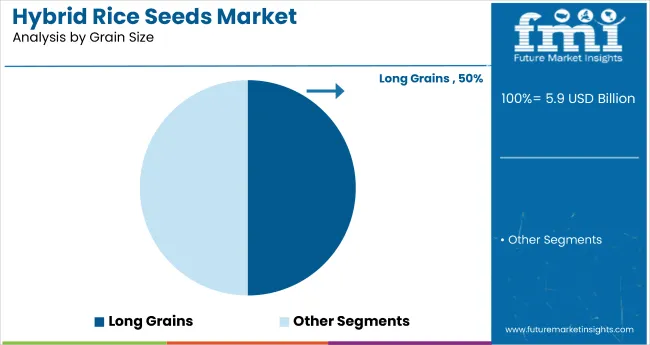
Long grains are projected to lead the grain size segment, capturing 50% of the market share by 2025. These varieties are gaining preference in the UK, USA, Japan, Germany, and France for their higher yield and longer shelf life.
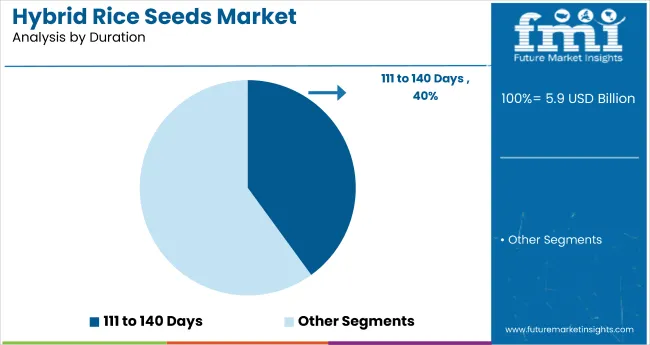
Hybrid rice seeds with a growing duration of 111 to 140 days are expected to lead the duration segment, capturing 40% of the global market share by 2025, favored for their optimal yield and adaptability.
The global hybrid rice seeds market is experiencing steady growth, driven by the increasing demand for higher yields, improved pest resistance, and the need to meet food security challenges across regions. Hybrid rice seeds play a crucial role in enhancing agricultural productivity and ensuring food supply stability.
Recent Trends in the Hybrid Rice Seeds Market
Challenges in the Hybrid Rice Seeds Market
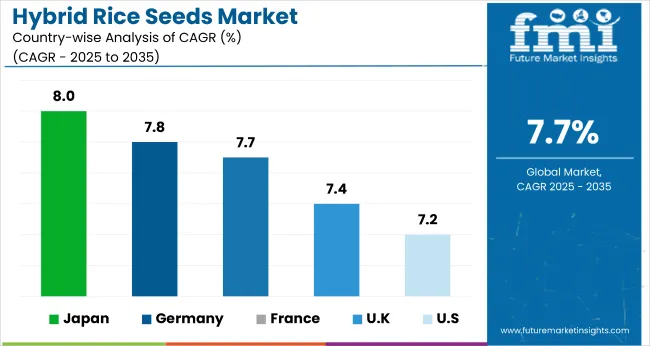
Japan's momentum is driven by advanced agricultural technologies and government-driven food security initiatives. Germany and France maintain steady demand, supported by EU sustainability goals and funding for agricultural modernization under the Green Deal. In contrast, developed economies like the USA (7.2% CAGR), UK (7.4%), and Japan (8%) are expected to expand at a steady 0.91-1.05x of the global growth rate.
The Japan hybrid rice seed market is experiencing the highest growth, driven by advancements in technology and precision farming. Germany and France both exhibit strong growth, fueled by EU sustainability goals and climate resilience measures. The USA follows closely with robust demand, especially from research-driven farming programs in states like Arkansas and Louisiana.
The UK has the slowest growth rate, influenced by post-Brexit regulatory challenges, but continues to show steady demand in small- and medium-scale organic farming. Overall, Japan leads in growth, while the UK sees the most modest expansion among these countries.
The report covers in-depth analysis of 40+ countries; five top-performing OECD countries are highlighted below.
The Japan hybrid rice seed revenue is growing at a CAGR of 8% from 2025 to 2035. Growth is driven by agricultural modernization and government policies focused on sustainable rice production. Japan’s technology-driven agricultural landscape prioritizes high-efficiency hybrid varieties, integrated with automated farming systems.
The sales of hybrid rice seeds in Germany are expected to expand at 7.8% CAGR during the forecast period, slightly below the global average but strongly regulation-led. EU food security goals, climate change adaptation measures, and sustainable farming practices are driving the adoption of hybrid rice seeds.
The French hybrid rice seed market is projected to grow at a 7.7% CAGR during the forecast period, in line with the global market growth rate. Demand is driven by national food security targets, sustainable farming regulations, and regional rice cultivation initiatives. Hybrid rice seeds are being adopted in regions requiring efficient and eco-friendly farming solutions.
The USA hybrid rice seed market is projected to grow at a 7.2% CAGR from 2025 to 2035, translating to 0.93x the global growth rate. USA demand is primarily driven by research and technology adoption in rice farming, especially in states like Arkansas and Louisiana. The market is focused on improving yield and pest resistance in hybrid rice varieties, supporting food security.
The UK hybrid rice seed revenue is projected to grow at a 7.4% CAGR from 2025 to 2035, slightly below the global average. Growth is supported by government initiatives promoting sustainable agriculture, with increasing interest in hybrid varieties that offer better yield and resilience.
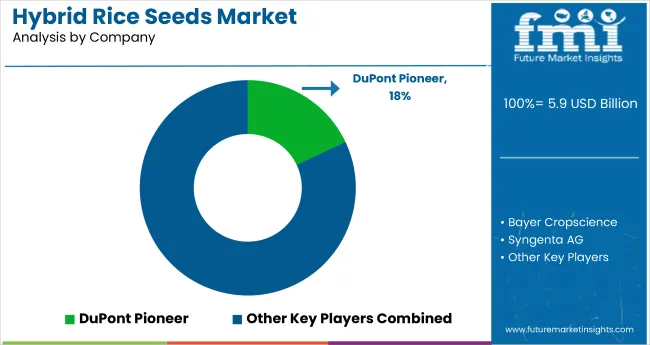
The market is moderately consolidated, with leading players such as DuPont Pioneer, Bayer Cropscience, Syngenta AG, and Advanta Limited dominating the industry. These companies provide high-quality, genetically engineered hybrid rice varieties tailored to meet the demands of diverse agricultural conditions.
DuPont Pioneer focuses on high-yield, drought-resistant varieties, while Bayer Cropscience specializes in developing climate-resilient hybrid rice seeds. Syngenta AG offers seeds optimized for pest resistance and high productivity, and Advanta Limited is known for its diverse hybrid varieties suited for different soil types.
Other key players, including BioSeeds Research India Pvt. Ltd., Biostadt India Limited, Krishidhan Seeds Pvt. Ltd., and Nuziveedu Seeds Ltd., contribute to the market by offering specialized, region-specific hybrid varieties that cater to the needs of small- and large-scale rice farmers.
Recent Hybrid Rice Seeds Industry News
In June 2024, RiceTec, Inc. launched FullPage Rice Cropping Solution with its Indian affiliate Savannah Seeds, also in collaboration with a global crop protection company, ADAMA. FullPage integrates SmartRice genetics as its specifically tailored for direct seeded rice, SQUAD seed treatment, the unique IMI herbicide tolerance trait, and ADAMA’s Vezir herbicide.
| Report Attributes | Details |
|---|---|
| Market Size (2025) | USD 5.9 billion |
| Projected Market Size (2035) | USD 12.4 billion |
| CAGR (2025 to 2035) | 7.7% |
| Base Year for Estimation | 2024 |
| Historical Period | 2020 to 2024 |
| Projections Period | 2025 to 2035 |
| Report Parameter | USD billion for value/ volume in metric tons |
| Grain Size Analyzed | Long Grains, Medium-Sized Grains, Sand hort Grains |
| Duration Analyzed | 111 to 140 Days, 140+ Days, and Up To 110 Days |
| Region Analyzed | North America, Latin America, Western Europe, South Asia, East Asia, Eastern Europe, Middle East & Africa |
| Countries Covered | United States, United Kingdom, Germany, France, Japan, China, India, Brazil, South Korea, Australia add this 40+ countries in report scope |
| Key Players Influencing the Market | DuPont Pioneer, Bayer Cropscience, Syngenta AG, Advanta Limited, BioSeeds Research India Pvt. Ltd., Biostadt India Limited, Krishidhan Seeds Pvt. Ltd., Nuziveedu Seeds Ltd., Rasi Seeds (P) Ltd., RiceTec Inc., Ankur Seeds Pvt. Ltd., Ganga Kaveri Seeds Pvt. Ltd., Nath Bio-Genes (I) Ltd., SL Agritech Corporation, Nirmal Seeds Pvt. Ltd. |
| Additional Attributes | Dollar sales by grain size, share by duration, regional demand growth, policy influence, government support, competitive benchmarking |
The market is valued at USD 5.9 billion in 2025.
The market is forecasted to reach USD 12.4 billion by 2035, reflecting a CAGR of 7.7%.
Long grains will lead the grain size segment, accounting for 50% of the global market share in 2025.
Hybrid rice seeds with a growing duration of 111 to 140 days will dominate the duration segment, capturing 40% of the global market share in 2025.
Japan is projected to grow at the fastest rate, with a CAGR of 8% from 2025 to 2035.
Explore Similar Insights

Thank you!
You will receive an email from our Business Development Manager. Please be sure to check your SPAM/JUNK folder too.